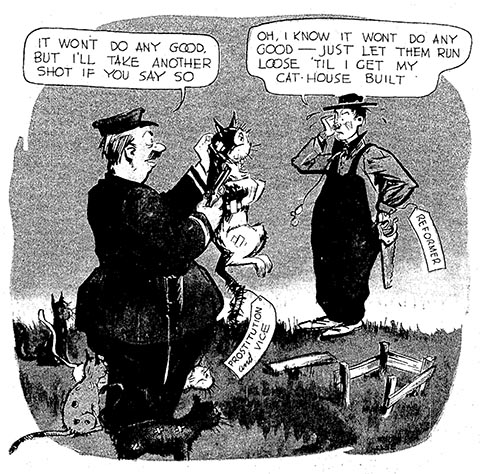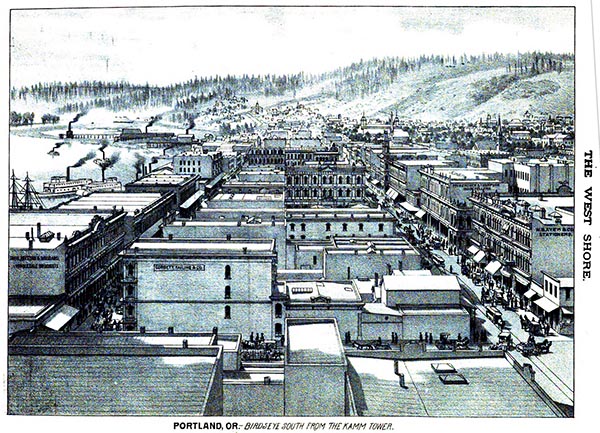PORTLAND, MULTNOMAH COUNTY; 1890s:
‘Home for Wayward Girls and Fallen Women’ a bust
Audio version: Download MP3 or use controls below:
|

The first to face prosecution was Della Burris, up on a charge of Operating a Bawdy House. Della coolly pleaded Not Guilty; the prosecution asserted that everybody KNEW she was running a brothel; and the judge promptly dismissed the case. “Common fame and general reputation are not sufficient evidence to convict anyone of keeping a bawdy house,” he remarked. The next defendant got pretty much the same treatment. And the next. And the next. It turned out the cops, in bringing the ladies in, had simply been arresting them, collecting no evidence. The district attorney was simply filing charges against them, making no investigations. Without evidence, there could be no convictions. And this happened again and again. The most likely explanation for this uncharacteristically cavalier attitude toward law enforcement was articulated very neatly by the editor of the Morning Oregonian on its editorial page on April 10: “The District Attorney gets $5 for every arrest; $7.50 for trial; and $15 for convictions,” the editor wrote tartly. “In each case, having taken pains to draw all the indictments separately, if there are no convictions, he will make from $500 to $600. The police justices and constables make about $12 out of each case, or as much more, and the county foots the bill. This is the total visible profit of the moral crusade so far — about $1,200 diverted from the pockets of taxpayers to those of officials.” In other words, some clever devil had figured out that the authorities were essentially working on commission. Reformers having demanded action from them, they’d realized that such pressure was like a license to print money — and who were they to refuse such a clear call to action from the citizenry, anyway?
BUT MEANWHILE, THE law enforcement pressure looked like it was having its intended effect on Portland’s ladies of the evening. One by one, the Rose City’s Roxannes wandered into The Open Door and settled in, apparently ready to put away their makeup and embrace the clean and sober life. By late June, The Open Door was starting to look like a big success. Then the logging camps shut down for the traditional “Fourth of July Drunk,” and Portland was suddenly flooded with strapping young lads smelling of sawdust and pitch and whiskey, freshly paid and ready to “blow ’er in.” And a funny thing started happening: The Wayward Women started melting away from The Open Door. They’d go out shopping and just never come back. It turned out the opening of The Open Door had just happened to coincide precisely with the least lucrative time of the year for Portland prostitutes — the late spring and early summer season, when the loggers were all hard at work in the woods. The ladies had been happy to check in for a few weeks and enjoy free room and board. But now the boys were back in town, and it was time to go get some of their money. Soon Mrs. Lucy Morgan was alone in the big empty house, listening to roaring-drunk loggers and Fallen Women cavorting around in the streets outside. A few weeks later, the demoralized reformers gave up on the whole thing.
|
Background photo is a postcard image showing the summit of Middle Sister, from a picture postcard published around 1950.
Scroll sideways to move the article aside for a better view.
Looking for more?
On our Sortable Master Directory you can search by keywords, locations, or historical timeframes. Hover your mouse over the headlines to read the first few paragraphs (or a summary of the story) in a pop-up box.
... or ...

©2008-2014 by Finn J.D. John. Copyright assertion does not apply to assets that are in the public domain or are used by permission.

